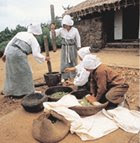 Jeju has a very unique, traditional dialect.
Jeju has a very unique, traditional dialect.We can't know, especially guessing also difficult.
I thought it also kind of foreign language.
I need a translation. maybe everyone don't know except jeju citizen.

 With Seopseom and Beomseom Island in front, the Jeongbang Waterfall is right at the edge of the ocean. The Jeju people believed that a holy dragon lived under the waterfall. It has been said that since the water has its spirit, it has cured illnesses and caused rain to fall during a drought. In addition, there is another small waterfall nearby, looking like a servant waiting on a dignified lord. Thats why it was chosen as one of the scenic wonders of Jeju among other big waterfalls in Jeju.
With Seopseom and Beomseom Island in front, the Jeongbang Waterfall is right at the edge of the ocean. The Jeju people believed that a holy dragon lived under the waterfall. It has been said that since the water has its spirit, it has cured illnesses and caused rain to fall during a drought. In addition, there is another small waterfall nearby, looking like a servant waiting on a dignified lord. Thats why it was chosen as one of the scenic wonders of Jeju among other big waterfalls in Jeju. The crater of Sunrise Peak consists of 99 rock peaks along its rim that look as if they are escorting the crater and forming a castle. For that reason, the basin was considered to be holy, and itwas named "Seongsan" which literally means holy mountain. The view of the sunrise here is truly remarkable.
The crater of Sunrise Peak consists of 99 rock peaks along its rim that look as if they are escorting the crater and forming a castle. For that reason, the basin was considered to be holy, and itwas named "Seongsan" which literally means holy mountain. The view of the sunrise here is truly remarkable.




 Picture of Mt. Halla in jeju island.
Picture of Mt. Halla in jeju island.


Located in Northeast Asia,
Korea Connects Eastern Continents and Seas.
Have you heard of the "1988 Seoul Olympic Game" or the "2002 World Cup"? You may answer, 'Yes'. Well, do you know where Korea is located? Even though many friends from abroad are aware of the Olympic games or World Cup games, most of them don't know where those big world events were held. It is partly because that Korean is not big country that you can easily find on the map.
commercial of korea.
actually I like advertisement too. (I have a IAA Ad Diploma)
It contains everything and deal with something special.
 Hi
Hi wanna be a global minded person who majoring korean lanuage education. site managing motto is one day, one posting at least. I will be expanding my cultural horizons through this site so let's together. know who I am, know Who We are, and be proud.
